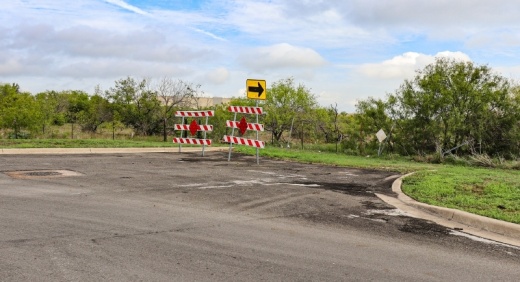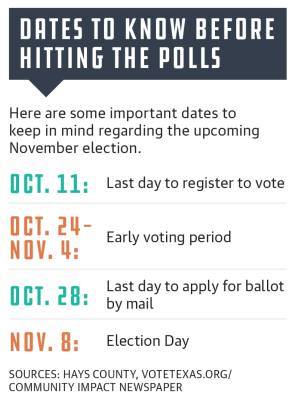The $294 million bond is broken down into a number of ways: preliminary engineering, right-of-way acquisition, utilities, design, construction, and The Vybe integration and construction as well as general engineering consultant fees.
“We are living through really tough times; I wanted to make sure the bond that we put out was the closest estimate we could get,” Flores-Cale told Community Impact Newspaper.
“It was originally going to be a 2021 road bond, but we just weren’t ready, so this entire fiscal year has been in anticipation of a road bond,” Mayor Travis Mitchell said.
The city’s previous road bond was in 2013 at $36 million for work on five roads: North Burleson Street, Marketplace Avenue, Goforth Road, Bunton Creek Road and Lehman Road.
“The goal is twice the roads in half the time from the 2013 bond,” Mitchell said.
The new bond revisits some of those roads, though it trumps the price tag at $294 million for 10.3 miles of new and reconstructed roads: Bebee Road, Bunton Creek Road, Old Stagecoach Road and Center Street, Center Street (On-System), Kohlers Overpass, the Kyle Parkway Lehman Extension, Marketplace Avenue and Windy Hill Road.
Mitchell added that every project the city takes on should be bigger than its predecessor, especially since Kyle has grown so much since the 2013 bond.
However, some council members differed on the focal point of the bond.
“For me, it was all about necessity,” Flores-Cale said. “What do we need right now? What [did] we need 10 years ago?”
The city of Kyle has grown 63.11% in 10 years, according to data from the U.S. Census Bureau. The city’s population in 2010 sat at around 28,000 residents; the most recent census in 2020 shows the population nearly doubled and is now at around 45,000 residents.
“We are not the little town we used to be,” Mitchell said. “We absolutely need to build roads—not just any roads, well-engineered roads.”
Actualizing Proposition A
The council tapped Gap Strategies, a firm that helps public officials and private entities with policies and communication, in 2021 to work on the public engagement aspect of the road bond while bringing aboard company K. Friese and Associates to conduct engineering work for the bond.
In April, City Council approved preliminary reports from six engineering firms on a handful of roads that were to be on the 2022 road bond. The agreements were executed in May to the tune of just under $1 million from the general fund for reports from Cobb, Fendley & Associates Inc.; RPS Infrastructure Inc.; Kimley-Horn & Associates; BGE Inc.; Lockwood, Andrews & Newman Inc.; and American Structure Point Inc.
Each engineering firm was given a specific road project to focus on to develop a design schematic, studies in support of the schematic, assess potential challenges and opportunities for the project, frame a schedule for development, refine cost estimates and more.
The framework for the plans created by each firm will be based on various city master plans and criteria outlined by the Texas Department of Transportation.
Preliminary plans, sometimes referred to as 10% plans, are meant to do just enough data gathering, collection and analysis to understand what the project as a whole will entail, said Joe Cantalupo, senior vice president of K. Friese & Associates, at the Aug. 22 meeting.
In meetings throughout June, July and August, the council got closer to a solidified bond package to send to the voters through workshop meetings.
Previous meetings had brought discussion about splitting reconstructed roads into one proposition and new roads into another.
“There were going to be two separate bonds, and during [a meeting] a council member made a motion to put it all in one bond and that, to me, was a breaking point,” Flores-Cale said. “There’s an underpass and an overpass going from the [FM] 1626 area that goes all the way to I-35 that I do not think we need right now. I think, eventually, when there is development in the area on the east side, we should consider it then. But right now, I cannot say the road is going to lead anywhere that [will be beneficial].”
Ultimately, the council landed on an all-or-nothing plan in July: Proposition A with all roads included.
East versus west
The growth that the city has experienced over the past 10 years or so has put a strain on the existing road network. The 2022 bond is not necessarily aimed at addressing the growth and population where the city currently stands but is aimed at the anticipated growth over the next decade, Gap Strategies Principal Jeff Barton said at the Aug. 22 council meeting.
“Kyle has grown about 64% just since 2010,” Barton said. “And you have not only grown in people, you have grown in area; about 30% with the annexation that you have accomplished.”
Barton added that while the road work weighs heavily on the east side of Kyle, the bond should be seen as a whole.
“You cannot really look at this in total isolation between east side roads and west side roads because what it builds is a total network that allows the city to move,” Barton said. “Several of these roads are designed to move back and forth between east and the west side of Kyle.”
The contention of east versus west in Kyle is an ongoing discussion that Mitchell speculates could have been kickstarted with the city’s first big development in the late 1990s, Plum Creek.
“[Plum Creek] was the first big development that came to Kyle and put us on the map [around] 25 years ago. It was this massive, master-planned subdivision that came into town, all on the west side. It got a lot of incentives and special considerations,” Mitchell said. “It was all good and right for it to happen, but east side development proposals did not necessarily get those things.”
Flores-Cale added that just by driving on the east side of Kyle, there is a significant difference in the roads and infrastructure in place.
“We are 10 steps behind, probably 10 years behind on the things they should have been working on while bringing in [development],” she said. “This bond has a lot of things: It has the lights; it has the sidewalks; and I can appreciate that because the east side really needs those kind of add-ons.”
Barton said that in order for the city to spur economic development and growth—which the council has expressed interest in—on the east side of Kyle, the proper infrastructure needs to be in place, which this bond will help achieve.
Cost to taxpayers
In the final presentation to the dais before the election was called, Cantalupo said that the revised bond package is around $4 million less based on adjustments that were made at the direction of the council.
“We try to be conservative in our estimates going forward; on the taxable growth, you have averaged a little over 15% the last 10 years. We estimate a 10% growth from tax years [2023] -[2026] and then 2% after that,” SAMCO Capital Managing Director Ryan Cunningham said.
He added that the projects can move faster or slower depending on how the growth within the city presents itself over time.
If approved by voters, the city tax rate will increase by $0.0917 per $100 evaluation, according to the city.
“If the voters approve, we are going to be able to green-light multiple projects and really see some action here within just a few years’ time,” Mitchell said.
City staff and Gap Strategies will host an in-person open house session Oct. 1 to meet with residents and answer any questions that may linger. The session will be held at City Hall located at 100 W. Center St., Kyle. The city has also created a website so residents can see the map of the roads and see other pertinent information regarding the election: www.kylebonds.com.








